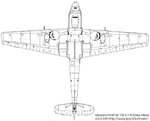A
Anonymous
Guest
Chiron said:Man, thats record is amazing!
But, how did Japanese pilots LEARN to counter US air superiority? I meant Kamikazi was used to destroy ships, Japanese airmen must learned to how to maintain their control of air, right? Zeros maybe now outclassed by Hellcats, but proper tactics maybe still useful.
LOL - they didn't! It's as simple as that.

